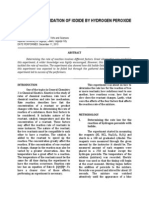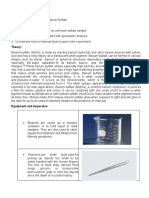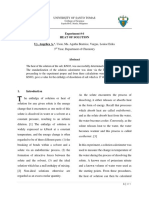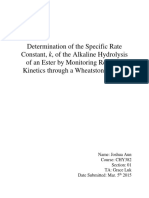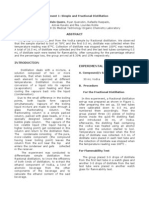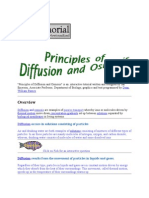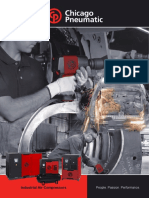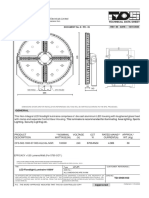Experiment 1 (Simple and Fractional Distillation)
Experiment 1 (Simple and Fractional Distillation)
Uploaded by
Cheng BauzonCopyright:
Available Formats
Experiment 1 (Simple and Fractional Distillation)
Experiment 1 (Simple and Fractional Distillation)
Uploaded by
Cheng BauzonCopyright
Available Formats
Share this document
Did you find this document useful?
Is this content inappropriate?
Copyright:
Available Formats
Experiment 1 (Simple and Fractional Distillation)
Experiment 1 (Simple and Fractional Distillation)
Uploaded by
Cheng BauzonCopyright:
Available Formats
1
Simple and Fractional Distillation
Adolfo, Angela Nicole G.*, Alcaraz, Frances Jillian F.
Aliman, Stephanie T., Astor, Jashmin D.
Bauzon, Franchesca D., Cabral, Danica Rose G.
Department of Pharmacy, Faculty of Pharmacy
University of Santo Tomas
ABSTRACT
Distillation is one of the oldest and still most common methods for both the
purification and the identification of organic liquids. It is a physical process used to
separate chemicals from a mixture by the difference in how easily they vaporize. The
experiment used the Simple Distillation Method to separate the components of 30 mL
alcohol (vodka) and water. The distillate was collected with the aid of a calibrated test
tube (0.5 mL) until it reaches the temperature of 99 C. Also, the first, second and last
distillate were used for testing the presence of alcohol. Throughout the process, there is
a directly proportional relationship between the volume and temperature of the distillate.
In the flammability test, the first and second distillate shows the presence of alcohol
while the last one is not flammable at all. With the records obtained, a graph between
the volume and temperature of distillate was plotted and the percentage of alcohol and
percentage loss were also computed. Thus, simple distillation is not a so much complex
process of extraction and purifying liquids. Heating and vaporization are just the 2 major
process used to separate the components of alcohol (vodka) and water.
mixture by selective condensation and
INTRODUCTION
evaporation. It is a process of purifying
compounds by means of separating
Distillation is used to separate
the
component substances from a liquid
more volatile substance from non-volatile
or less volatile substance. There are two
types of distillation, namely simple and
fractional.
Fractional
distillation
is
which the condensed vapor is collected.
essentially the same as simple distillation
These instruments were tightly
except that a fractionating column is
secured to prevent breakage of the
placed between the boiling flask and the
apparatuses. First, in the distilling flask
condenser. The fractionating column is
containing pieces of boiling stones, a
usually filled with glass or plastic beads.
30mL of vodka was added. The flask was
heated with an alcohol lamp constantly.
In the experiment, the simple
Ideally, the substance with the lowest
distillation was used to separate the
boiling
point
vaporizes
first
the
components substances of the vodka.
temperature remaining constant until that
The following are the objectives to be
substance has completely distilled. The
achieved by the group:
vapor is led into the condenser where, on
being cooled, it reverts to the liquid
1.)
To
be
able
to
separate
the
(condenses) and runs off into a calibrated
components of the alcoholic beverage
test tube that serves as a receiving
(vodka) by distillation.
vessel. The one obtained is called as the
2.) To set up a distillation curve.
distillate and those substances having a
3.) To calculate the percent ethanol
higher boiling point remain in the flask
present in the vodka.
and constitute the residue.
4.) To compare the simple and fractional
distillation process efficiency in terms of
separating mixtures of liquid.
After which, the temperature of
the first drop in every test tube was
recorded until it reached the temperature
METHODOLOGY
of 99 C. The first, second and last
distillate were used to test its flammability
A simple distillation apparatus
in a watch glass. The distilling flask was
consists essentially of three parts: a flask
cooled and the volume of the residue was
equipped with a thermometer and with an
recorded.
outlet tube from which the vapor is
temperature then was plotted in a graph
emitted; a condenser that consists of two
and the percentage of alcohol present in
tubes of placed one within the other and
the distillates were computed. On the
so arranged that the smaller (in which the
contrary, the percentage loss was also
vapor is condensed) is held in a stream of
computed.
coolant in the larger; and a vessel in
The
volume
and
the
Distillate
First
Second
Last
RESULTS AND DISCUSSION
Flame Test
+
+
-
Table 1. Volume and Temperature
Table 2 shows that a positive
of Distillate
TEST
VOLUME
TUBE
(mL)
0.5
1.0
1.5
2.0
2.5
3.0
3.5
4.0
4.5
5.0
5.5
6.0
6.5
7.0
7.5
8.0
8.5
9.0
9.5
10.0
10.5
11.0
11.5
12.0
1
2
3
4
5
6
7
8
9
10
11
12
13
14
15
16
17
18
19
20
21
22
23
24
TEMPERATURE
result in the flame test indicates the
(C)
presence of alcohol and a negative result
83
84
84
84
84
85
87
88
88
89
90
91
92
92
93
94
95
95
96
96
97
98
98
99
indicates that there is no alcohol. In the
first and second distillate, a blue with
orange tip flames was produced while the
last distillate did not produce any flame. It
shows that as the distillation continues,
the amount of alcohol decreases.
Table 1 shows that as the volume
of distillate increases, the temperature
also
increase
until
it
reaches
Figure 1. Simple Distillation Setup
the
temperature of 99 C. It shows that the
Figure 1 shows the setup where
volume and temperature are directly
the distillation was held. Since there is no
proportional.
fractionating column present, it is only just
a Simple Distillation setup.
Table 2. Flammability of Distillate
is usually the atmospheric pressure. The
vapor pressure is a very sensitive function
of temperature. It does not increase
linearly but in fact increases exponentially
with temperature, showing that there they
are directly proportional with each other.
When the vapor pressure of the liquid
equals the applied pressure, the liquid
Figure 2. Graph of Temperature and
boils. Thus, the boiling point of a liquid is
Volume of Distillate
the temperature at which the vapor
pressure equals the applied pressure.
Figure 2 shows that as the
The normal boiling point of a liquid is the
mixture is heated, the temperature rises
temperature at which the vapor pressure
until it reaches the temperature of the
of a liquid equals atmospheric pressure
lowest boiling substance in the mixture.
(1 atm). The boiling point of a liquid is a
The resultant hot vapor passes into a
measure of its volatility and its purity.
condenser and is converted to the liquid,
CALCULATIONS
which is then collected in a receiver flask.
The other components of the mixture
%v/v alcohol = Vf - Vi x 100
remain in their original phase until the
Vs
most volatile substance has all boiled off.
Only then does the temperature of the
= 12.0 - 0 x 100
gas phase rises again until it reaches the
30
boiling point of a second component in
the mixture, and so on.
= 40 % alcohol
This is the underlying principle
behind
distillation.
At
any
given
%loss = Vs - (Vd + Vr) x 100
Vs
temperature a liquid is in equilibrium with
its vapor. This equilibrium is described by
= 30 - (12.0 + 12.0) x 100
the vapor pressure of the liquid. The
30
vapor pressure is the pressure that the
molecules at the surface of the liquid
exert against the external pressure, which
= 20 % loss
CONCLUSION
increases,
the
presence
of
alcohol
decreases and also making the mixture
In the experiment, it was fairly
not flammable.
observed the fact that the process of
distillation of simple and fractional are not
REFERENCES
much
Helmenstine, A. (2016). Understand the
principles of distillation. About
education, 1-5. Retrieved from
http://chemistry.about.com/cs/5/f/bldi
tillation.htm
different
except
for
the
augmentation of the apparatus of the
fractional distillation. It is known as the
fractionating column that is usually filled
with glass or plastic beads. These beads
improve the separation between the
liquids being distilled. The reason that
fractional
distillation
gives
better
separation between the liquids is because
the glass beads in the fractionating
Natural Ingredient Resource Center.
(2015, May). Boiling points and
distillation. Retrieved from
http://naturalingredient.org/wp/wp-con
tent/uploads/Distillation.pdf
Winkle, M. v. (1967). Mass Transfer
Processes.
In
M. v.
Cinkle,
Distillation. New York: McGraw-Hill.
column provide "theoretical plates" on
which the refluxing liquid can condense,
re-evaporate,
and
condense
again,
essentially distilling the compound over
and
over.
distillation
Other
is
than
simple
that,
simple
process
of
extraction and purifying liquids by heating
and vaporization of the components of
alcohol (vodka) and water. Thus, based
on the experiment, as the temperature
DOCUMENTATION
Yoder, C. (2016). Distillation. Wired
chemist. Retrieved from
http://www.wiredchemist.com/chemist
ry/instructional/laboratory-tutorials/dis
tillation
You might also like
- Week 2 Lab ReportDocument11 pagesWeek 2 Lab ReportTina VargheseNo ratings yet
- Organic Chemistry Lab Report - DistillationDocument7 pagesOrganic Chemistry Lab Report - DistillationPreeti Gunthey DiwanNo ratings yet
- Recrystallization of Acetanilide Organic ChemistryDocument6 pagesRecrystallization of Acetanilide Organic ChemistryBangkit Putra SagaraNo ratings yet
- Experiment 1-Acid-Based ExtractionDocument7 pagesExperiment 1-Acid-Based Extractionbabywenn100% (15)
- SEPAAAAADocument2 pagesSEPAAAAAAGEO JUSTINE ANGELESNo ratings yet
- Lab Report 1 Diffusion Across Biological Membrances SimulationDocument7 pagesLab Report 1 Diffusion Across Biological Membrances SimulationAmeena Ali50% (2)
- Gravimetric Determination of Moisture CoDocument5 pagesGravimetric Determination of Moisture CoDEFIN BIMA REYNANDANo ratings yet
- Distribution CoefficientDocument23 pagesDistribution CoefficientJim100% (1)
- Lab Introduction To Gel ElectrophoresisDocument3 pagesLab Introduction To Gel Electrophoresisapi-382372564100% (1)
- Kinetics: The Oxidation of Iodide by Hydrogen PeroxideDocument3 pagesKinetics: The Oxidation of Iodide by Hydrogen PeroxideHazel Abagat-DazaNo ratings yet
- Distillation: Separation and Purification of SubstancesDocument3 pagesDistillation: Separation and Purification of SubstancesVince100% (1)
- Physical Properties of Organic Compounds 1Document4 pagesPhysical Properties of Organic Compounds 1deborah07No ratings yet
- Chem 160.1 Ex2 BufferDocument8 pagesChem 160.1 Ex2 BufferAsi JenNo ratings yet
- Simple and Steam Distillation Exp3.Document5 pagesSimple and Steam Distillation Exp3.paoloNo ratings yet
- Pune Industries DatabaseDocument48 pagesPune Industries Databasesrujanjam50% (2)
- KSB Selecting Centrifugal PumpsDocument92 pagesKSB Selecting Centrifugal Pumps윤홍민100% (3)
- Hexane and Toluene Simple and Fractional DistillationDocument12 pagesHexane and Toluene Simple and Fractional Distillationrodneyperu0% (1)
- Example of Lab ReportDocument15 pagesExample of Lab ReportElouisa OlaybalNo ratings yet
- CE - Experiment 2 Extraction With Acid and AlkalineDocument8 pagesCE - Experiment 2 Extraction With Acid and AlkalineWeiChingNo ratings yet
- Q2015 Physical Chemistry Measurements Laboratory Chemistry Department, Campus Monterrey Practice # 8 Distribution CoefficientDocument4 pagesQ2015 Physical Chemistry Measurements Laboratory Chemistry Department, Campus Monterrey Practice # 8 Distribution Coefficientandres_guadiana_7362100% (1)
- Experiment 3 Lab ReportDocument10 pagesExperiment 3 Lab ReportVanessa Denise AguilarNo ratings yet
- Chapter 1 Lab ReportDocument5 pagesChapter 1 Lab ReportJabin Sta. TeresaNo ratings yet
- Lab 2Document5 pagesLab 2tariqwaece100% (2)
- Determination of S As Barium SulfateDocument7 pagesDetermination of S As Barium SulfateRon AguilarNo ratings yet
- Exp. 8 Diffusion of Sodium Chloride in WaterDocument6 pagesExp. 8 Diffusion of Sodium Chloride in WaterElaine Pui33% (3)
- Absorption Spectrum of A Conjugated DyeDocument6 pagesAbsorption Spectrum of A Conjugated DyeKing Everest100% (1)
- Ed Post Lab Heat of Formation of NaClDocument4 pagesEd Post Lab Heat of Formation of NaClEdimar ManlangitNo ratings yet
- Exp 3 Formal Lab ReportDocument3 pagesExp 3 Formal Lab ReportRomulo Vincent Perez100% (1)
- Lab ReportDocument10 pagesLab ReportKathleen De Vera Barril100% (1)
- Laboratory Report - EvaporationDocument14 pagesLaboratory Report - EvaporationWayne Tandingan0% (1)
- Experiment 4 - DistributionDocument14 pagesExperiment 4 - DistributionVanessa Denise Aguilar92% (12)
- Exp 5 - EutecticDocument7 pagesExp 5 - EutecticFath Bond60% (5)
- Vapor Pressure LabDocument3 pagesVapor Pressure Labzky_cardonaNo ratings yet
- Lab Report 1 (Che165)Document13 pagesLab Report 1 (Che165)Hazim Nahar0% (1)
- Experiment # 6 Heat of Solution Uy, Angelica A., Uson, Ma. Agatha Beatrice, Vargas, Louise ErikaDocument7 pagesExperiment # 6 Heat of Solution Uy, Angelica A., Uson, Ma. Agatha Beatrice, Vargas, Louise ErikaAngelica UyNo ratings yet
- Gas AbsorptionDocument33 pagesGas Absorptionirfan hilmanNo ratings yet
- EXP5-Determination of Partial Molar QuantitiesDocument2 pagesEXP5-Determination of Partial Molar QuantitiesMimah MoetmainahNo ratings yet
- Experiment 6. Adsorption Official Power PointDocument40 pagesExperiment 6. Adsorption Official Power PointElaine Tan100% (4)
- Qualitative Analysis Formal Report - AlcoholsDocument3 pagesQualitative Analysis Formal Report - AlcoholsPrincess Alyssa Abid100% (1)
- Triiodide Ion: Determination of An Equilibrium ConstantDocument5 pagesTriiodide Ion: Determination of An Equilibrium ConstantJericho LakampuengaNo ratings yet
- CHY382-01 Ester Hydrolysis Lab ReportDocument5 pagesCHY382-01 Ester Hydrolysis Lab ReportJoshua AunNo ratings yet
- Laboratory Experiment No. 11 - Transport Across MembranesDocument4 pagesLaboratory Experiment No. 11 - Transport Across MembranesMary Rose CatalbasNo ratings yet
- PW of Organic Chemistry: Unit 5: Synthesis of Acetophenone by Electrophilic Substituents (S)Document10 pagesPW of Organic Chemistry: Unit 5: Synthesis of Acetophenone by Electrophilic Substituents (S)TanChantreaNo ratings yet
- Determination of Chloride by Volhard and Mohr MethodDocument6 pagesDetermination of Chloride by Volhard and Mohr MethodShane AmolarNo ratings yet
- AP Chemistry - Titration Curves of Strong and Weak Acids and BasesDocument5 pagesAP Chemistry - Titration Curves of Strong and Weak Acids and BasesJonathan Chen100% (2)
- Empirical Formula Lab ReportDocument7 pagesEmpirical Formula Lab ReportSarah Marie BridgeNo ratings yet
- Che121l Experiment 1 Partial Molar VolumesDocument6 pagesChe121l Experiment 1 Partial Molar VolumesKim Lloyd A. Barrientos100% (1)
- Postlab 2 Gas AbsorptionDocument7 pagesPostlab 2 Gas AbsorptionDean Joyce Alboroto100% (1)
- Comparative Investigation of Organic CompoundsDocument5 pagesComparative Investigation of Organic CompoundsJames MaravillasNo ratings yet
- Expt 2: Ternary Phase DiagramDocument11 pagesExpt 2: Ternary Phase DiagramCha Canceran100% (1)
- Experiment 4 Laboratory ReportDocument13 pagesExperiment 4 Laboratory ReportXena Jenn Y. BacsarpaNo ratings yet
- Unit 2 TernerDocument26 pagesUnit 2 TernerRafidah AmaliaNo ratings yet
- Organic Chemistry Laboratory: Report 6: Reflux ReactionDocument7 pagesOrganic Chemistry Laboratory: Report 6: Reflux ReactionPhú NguyễnNo ratings yet
- Pseudo First Order ReactionsDocument5 pagesPseudo First Order ReactionsgiridharrajuNo ratings yet
- Experiment 4 Eutectic Point DeterminationDocument2 pagesExperiment 4 Eutectic Point DeterminationRuby DalyNo ratings yet
- Water PhenolDocument12 pagesWater PhenolChemistry DepartmentNo ratings yet
- Experiment 2Document8 pagesExperiment 2zidrick benjaminNo ratings yet
- Lab 2 Full Report PDFDocument20 pagesLab 2 Full Report PDFmuhammad ilyas100% (1)
- Distillation of VodkaDocument4 pagesDistillation of VodkaSharmaine Margaret LeeNo ratings yet
- Distillation Formal Lab ReportDocument8 pagesDistillation Formal Lab ReportPeter Ickes100% (2)
- Simple and Fractional Distillation - Formal ReportDocument3 pagesSimple and Fractional Distillation - Formal ReportBP Laforteza0% (3)
- Experiment 1Document4 pagesExperiment 1Lchg KrvyNo ratings yet
- Phil Lit Batch 2Document10 pagesPhil Lit Batch 2Cheng BauzonNo ratings yet
- Exp 4 BauzonDocument3 pagesExp 4 BauzonCheng BauzonNo ratings yet
- p6 Abstract (Exp3)Document1 pagep6 Abstract (Exp3)Cheng BauzonNo ratings yet
- Experiment 13 (Syntheses of Soap and Detergent)Document5 pagesExperiment 13 (Syntheses of Soap and Detergent)Cheng Bauzon100% (1)
- Experiment 12 (Synthesis of Acetylsalicylic Acid)Document8 pagesExperiment 12 (Synthesis of Acetylsalicylic Acid)Cheng Bauzon100% (1)
- Abstract - Density, Is The Mass of Unit Volume of A Substance, An Absolute Value Independent of The Gravitating ForceDocument1 pageAbstract - Density, Is The Mass of Unit Volume of A Substance, An Absolute Value Independent of The Gravitating ForceCheng BauzonNo ratings yet
- Paper Chromatography Formal Report ORG ChemDocument5 pagesPaper Chromatography Formal Report ORG ChemCheng BauzonNo ratings yet
- Experiment 3 (Sublimation and Melting Point Determination)Document13 pagesExperiment 3 (Sublimation and Melting Point Determination)Cheng BauzonNo ratings yet
- Conclusion ReferenceDocument1 pageConclusion ReferenceCheng Bauzon0% (1)
- Phar 5 Lab Activity 1 (Reviewer)Document5 pagesPhar 5 Lab Activity 1 (Reviewer)Cheng BauzonNo ratings yet
- Experiment 1Document5 pagesExperiment 1Cheng BauzonNo ratings yet
- Theology Assignment 110716 (Bauzon)Document2 pagesTheology Assignment 110716 (Bauzon)Cheng BauzonNo ratings yet
- Paper Chromatography Formal Report ORG ChemDocument5 pagesPaper Chromatography Formal Report ORG ChemCheng BauzonNo ratings yet
- Cathartic Article CH Go MedDocument4 pagesCathartic Article CH Go MedCheng BauzonNo ratings yet
- Transdermal Drug Delivery Systems (An Overview) PDFDocument9 pagesTransdermal Drug Delivery Systems (An Overview) PDFCheng BauzonNo ratings yet
- Iddle Ast Anufacture: of Pipe Cleaning EquipmentDocument12 pagesIddle Ast Anufacture: of Pipe Cleaning EquipmentArshed Jawad Al-mansoriNo ratings yet
- Tread StandardDocument117 pagesTread Standardsammysunny0324No ratings yet
- Influence of Limestone and Anhydrite On The Hydrat - 2014 - Cement and ConcreteDocument10 pagesInfluence of Limestone and Anhydrite On The Hydrat - 2014 - Cement and ConcreteFAJJAR OKTAVIANTO OKTAVIANTONo ratings yet
- SN0608098Document1 pageSN0608098AfshinSmaeilnezhadNo ratings yet
- Principles of Osmosis and DiffusionDocument17 pagesPrinciples of Osmosis and Diffusionallanlopez_2009No ratings yet
- Microbolometer LectureDocument5 pagesMicrobolometer LectureDilaawaiz FazalNo ratings yet
- 031120-Permanent Concrete FormingDocument7 pages031120-Permanent Concrete FormingjimmydomingojrNo ratings yet
- Material Product Data Sheet Chromium Carbide - 20 % Nickel Chromium PowdersDocument4 pagesMaterial Product Data Sheet Chromium Carbide - 20 % Nickel Chromium PowdersJesus D. Gutierrez G.No ratings yet
- Arab Pavement Publication 10 5265 401Document61 pagesArab Pavement Publication 10 5265 401HanafiahHamzahNo ratings yet
- Check ValveDocument2 pagesCheck ValveVaitheeswaran PalaniNo ratings yet
- Smokestack Chimney - PpeDocument5 pagesSmokestack Chimney - PpeMiguel OcampoNo ratings yet
- Nle11cnl 105h6174 r290 220v 50hz 09-2019 DsDocument6 pagesNle11cnl 105h6174 r290 220v 50hz 09-2019 Dspadilla.marcos.420No ratings yet
- Chicago Pneumatic Compressor 7.5 - 120HP WUX PDFDocument17 pagesChicago Pneumatic Compressor 7.5 - 120HP WUX PDFIpenu Sujarwo100% (1)
- BOQ-Mechanical - Option 2 (G+1+2)Document9 pagesBOQ-Mechanical - Option 2 (G+1+2)psn_kylmNo ratings yet
- Bhilai Steel Plant BhilaiDocument7 pagesBhilai Steel Plant BhilaiRahul PandeyNo ratings yet
- Technical Data Sheet: Crompton Greaves Consumer Electricals LimitedDocument2 pagesTechnical Data Sheet: Crompton Greaves Consumer Electricals LimitedAniNo ratings yet
- Utilization of Pulverized Oyster Shell and Pineapple Fiber For Fiber Cement Board Production 1Document4 pagesUtilization of Pulverized Oyster Shell and Pineapple Fiber For Fiber Cement Board Production 1TRISTAN REY BACLAAN100% (1)
- Plumbing Material SDocument57 pagesPlumbing Material SJonathan Delos SantosNo ratings yet
- Experimental Out-Of-Plane Behavior of Traditional Brick Masonry Infill WallsDocument12 pagesExperimental Out-Of-Plane Behavior of Traditional Brick Masonry Infill Wallsmd ashraful alamNo ratings yet
- Mci 2005 - 12 20 21Document3 pagesMci 2005 - 12 20 21Malak HindiNo ratings yet
- Standard Specifications Code of Practice Construction Oe Concrete RoadsDocument72 pagesStandard Specifications Code of Practice Construction Oe Concrete Roadsshankarswaminathan100% (1)
- Catb2001e A PDFDocument84 pagesCatb2001e A PDFEllyEsweNo ratings yet
- Globe or Touch Mobile 817 - 8311 Loc 148 and 149: Smart or Talk N Text TCGI Contact No.Document5 pagesGlobe or Touch Mobile 817 - 8311 Loc 148 and 149: Smart or Talk N Text TCGI Contact No.MarkNeilDeeNo ratings yet
- © Ncert Not To Be Republished: Changes Around UsDocument5 pages© Ncert Not To Be Republished: Changes Around Uskritagyasharma29No ratings yet
- STANVAC - Startrading CompanyDocument12 pagesSTANVAC - Startrading CompanyYohanes KrisNo ratings yet
- Plasma Cut PDFDocument8 pagesPlasma Cut PDFTraian TiberiuNo ratings yet
- 1 s2.0 S2238785421003227 MainDocument18 pages1 s2.0 S2238785421003227 MainManikandan ChinnachamyNo ratings yet
- Science 7 - Saturated and Unsaturated SolutionsDocument30 pagesScience 7 - Saturated and Unsaturated SolutionsJAEN KIETH ROCIOSNo ratings yet









